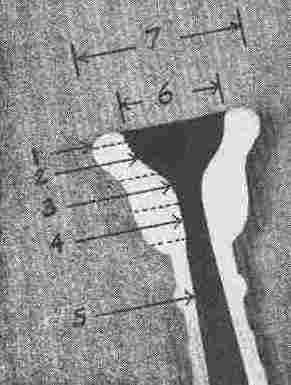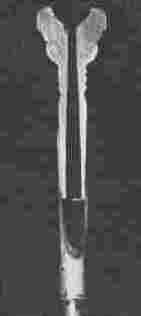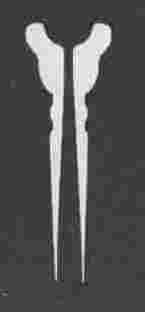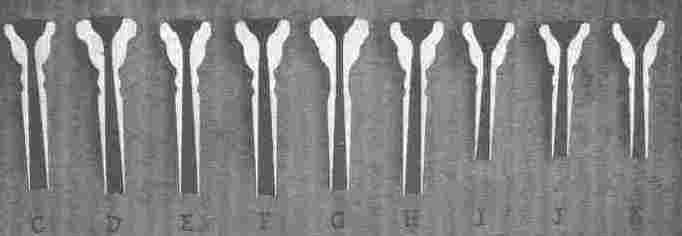Editor's note: This article was published originally in The Instrumentalist for November-December 1952, and subsequently anthologized in Brass Anthology, a book containing articles in the magazine's archives from 1946 to 1974. I am indebted to Matt Carey for providing me a transcription of the article and the scans of the figures. There are a couple of obvious errors in the original, e.g., matching reference numbers to the figures, that I have corrected.
In this symposium on mouthpieces of brass instruments The Instrumentalist presents for the first time the salient eight measurements of 213 different trumpet-cornet mouthpieces [which are not included here because so few of them are in current production--ed.] and a discussion of the purposes and functions of each part.
Any discussion of brass mouthpieces is always of interest to players of brass instruments as well as to directors of school bands and orchestras. Invariably, a discussion among brass experts starts with an expression that such and such a mouthpiece is the best, the poorest, or the producer of best results for one particular player. The argument that follows is mainly based on conjecture. Very seldom are the opinions or "conclusions" backed by sound reality or scientific evidence.
 In order
to clarify the situation, let us first identify the parts of a
mouthpiece so that we may have a ready vocabulary. Figure A [to the left] shows a trumpet
mouthpiece that has been cut in half. No. 1 is the rim, the
convex [i.e., curving outward, the outside of a bell] portion of the
upper part of the mouthpiece. No. 2 is the cup, the concave
[i.e., curving inward, the inside of a bell] portion as viewed from
above, which is located just below the rim. No. 3 is the
shoulder of the throat, a convex surface as viewed from above,
blending the cup into the throat.
In order
to clarify the situation, let us first identify the parts of a
mouthpiece so that we may have a ready vocabulary. Figure A [to the left] shows a trumpet
mouthpiece that has been cut in half. No. 1 is the rim, the
convex [i.e., curving outward, the outside of a bell] portion of the
upper part of the mouthpiece. No. 2 is the cup, the concave
[i.e., curving inward, the inside of a bell] portion as viewed from
above, which is located just below the rim. No. 3 is the
shoulder of the throat, a convex surface as viewed from above,
blending the cup into the throat.
No. 4 is the throat, generally cylindrical in shape and having straight or almost straight sides. The throat extends in length from perhaps 1/8 inch or less back to as much as 3/4 inch. No. 5 is the backbore, that part of the mouthpiece which extends from the throat to the lower end of the mouthpiece.
No. 6 is the width of the cup, its diameter on the inside of the rim. No. 7 is the outside diameter of the rim. The 8th critical measurement is diameter of the shank at the very bottom or end where the shank makes contact with the mouthpipe that is shown in part in Figure B [below] where the tubing inside the mouthpiece receiver pipe abuts, or should abut, the shank end of the mouthpiece.
 In
Figure B is shown a common deficiency in which there is an
appreciable gap between the end of the shank of the mouthpiece and
the beginning of the mouthpipe. The two should meet. To correct the
deficiency, the shank is turned down somewhat on a lathe so that it
will be small enough to meet the end of the mouthpipe. A marked
improvement in playing of the instrument is thereby effected.
In
Figure B is shown a common deficiency in which there is an
appreciable gap between the end of the shank of the mouthpiece and
the beginning of the mouthpipe. The two should meet. To correct the
deficiency, the shank is turned down somewhat on a lathe so that it
will be small enough to meet the end of the mouthpipe. A marked
improvement in playing of the instrument is thereby effected.
 Figure L [to the left] shows a cut-away
section of a mouthpiece and receiver pipe. Notice the substantial
overlap from the end of the shank to the mouthpiece. This is a
serious defect. Though it does not show a gap between the end of the
shank and the beginning of the mouthpipe as in B, it is
possible that if the shortcoming of B is remedied, the present
overlap as shown in L remains.
Figure L [to the left] shows a cut-away
section of a mouthpiece and receiver pipe. Notice the substantial
overlap from the end of the shank to the mouthpiece. This is a
serious defect. Though it does not show a gap between the end of the
shank and the beginning of the mouthpipe as in B, it is
possible that if the shortcoming of B is remedied, the present
overlap as shown in L remains.
The diameter of the inside of the mouthpipe at the point where it meets the mouthpiece shank is from .325 to .345 inches on most trumpets; however, since some shanks measure only .275 to .300 there is bound to be an overlap from the shank to the mouthpipe of 0.030 inches. This is the shortcoming shown at L.
In the correction of this shortcoming it is not desirable to ream out the shank with a reamer as this would change the contour too far up into the backbore. It is preferable to taper the shank opening with a cutting tool only about 3/8 inch. This the tapering remedies the shortcoming of L without appreciably altering the backbore of the mouthpiece.
Let us consider next the rim of the mouthpiece. Figure A [above] shows a mouthpiece with a desirable amount of roundness of the rim; it is especially well suited for beginners but is also used by many professional symphony players.
The narrower rim shown at C would give one more flexibility, such as demanded in playing arpeggios and intervals, than the rim shown in A. Yet flexibility is also dependent on another factor: the shape or outline of the rim curvature. Thus two mouthpieces may have an equally wide rim, but one will have a higher surface at the edge of the cup as shown in D, which produces the feeling of a narrow rim and yet has almost its flexibility, but when pressure is applied, the lips contact a relatively larger surface.
Thus this rim is a working compromise between the cushion feeling of the wide rim and the flexibility of the narrow rim. Obviously, such a mouthpiece is best suited to a player who tends to use more than ordinary pressure or who plays for long stretches of time as is the case with dance band players.
Experimental evidence and experience suggest that the higher the inner portion of the rim, as shown in D, the more accurate the attack is in both pianissimo and fortissimo playing. However, flexibility is sacrificed somewhat thereby. As the inner edge or "bite" becomes rounded, as in F, the more difficult becomes the attacks, but the greater is the flexibility.
 Let us
consider the cup next. A desirable cup for all-around performance is
shown in A. If precision of attack is the major requisite, the
cup shown in Figure M [to the
left] is preferable. This cup produces a stridency of tone that is
piercing. It is important that a cup of this shape have a high
shoulder at the throat (No. 3 in A) so that the shoulder
becomes more convex and less like a second cup, or duo-cup.
Let us
consider the cup next. A desirable cup for all-around performance is
shown in A. If precision of attack is the major requisite, the
cup shown in Figure M [to the
left] is preferable. This cup produces a stridency of tone that is
piercing. It is important that a cup of this shape have a high
shoulder at the throat (No. 3 in A) so that the shoulder
becomes more convex and less like a second cup, or duo-cup.
Mouthpiece H is an old French Besson (there is also an English Besson); I is the famous Arban's cornet mouthpiece; J is a modern mouthpiece of the former first trumpet of the Chicago Symphony, Mr. Llewellyn; K is the cornet mouthpiece of the renowned Jules Levy. It is interesting to compare these. Note especially the varying shapes of the backbores of G and H and the varying cups of I and K as compared to the others
The wider or more open we make the shoulder of the throat, the mellower becomes the tone. In I the throat and cup shape combine into one long cup similar to that in a French horn mouthpiece, which, if used on the trumpet, is colorless. It is possible to achieve a judicious combination with the shallow cup which aids the lip and still avoid the stridency of tone usually produced by such a mouthpiece as F. This is done by opening the shoulder somewhat as shown in E, resulting in the double-cup originally designed by L. A. Schmidt of Cologne about seventy years ago for use in the low F, E, Eb, and D trumpets used by R. Strauss. These latter instruments incidentally but significantly, were played in the upper harmonics like a French horn. The double-cup mouthpiece makes for easier control in the difficult high passages.
As shown in the dimensions of mouthpieces by Rohner, the average throat diameter uses a 27 drill size. Small throats of 30 or even smaller and extremely large throats of 18 or 19 used by some players, but these extremes should be avoided by the average player.
A throat made with a drill No. 27 having straight sides for as much as 3/4 inch will tend to cause the player to play sharp in the high register. On the other hand, if the straight sides of the throat are too short, the player will tend to play flat in the high register. Thus intonational tendencies, either sharp or flat, can usually be corrected in the mouthpiece.
If the backbore flares out rather rapidly, the tone will be full but slightly more difficult to control. If the backbore becomes straighter, with less flaring out, the tone becomes thinner but more easily controlled; at the same time the blowing resistance is increased.

Needless to say, the shape of the outside of the mouthpiece, provided there is adequate thickness of metal in the wall, has nothing to do with its playing qualities.
Finally, it is a physical impossibility to provide all the ideal features in any one mouthpiece; at best, a superior mouthpiece is an intelligent compromise of the major factors. The performer, thus, should strive for the optimum combination of factors. These will vary with the individual and the demands of the job and its playing standards. As a whole, one should favor tone quality and accurate intonation to ease of playing high notes unless the latter is a "must". No mouthpiece is perfect, and no mouthpiece will sound better than the player behind it. The player is still the major variable.
Extremes should be avoided whenever possible. This does not mean that everyone should use an average size mouthpiece, but an average size should be the most common one for beginners.
Excessive experimentation on the part of the player should be avoided; yet all players will benefit from careful thinking and trials on different mouthpieces.